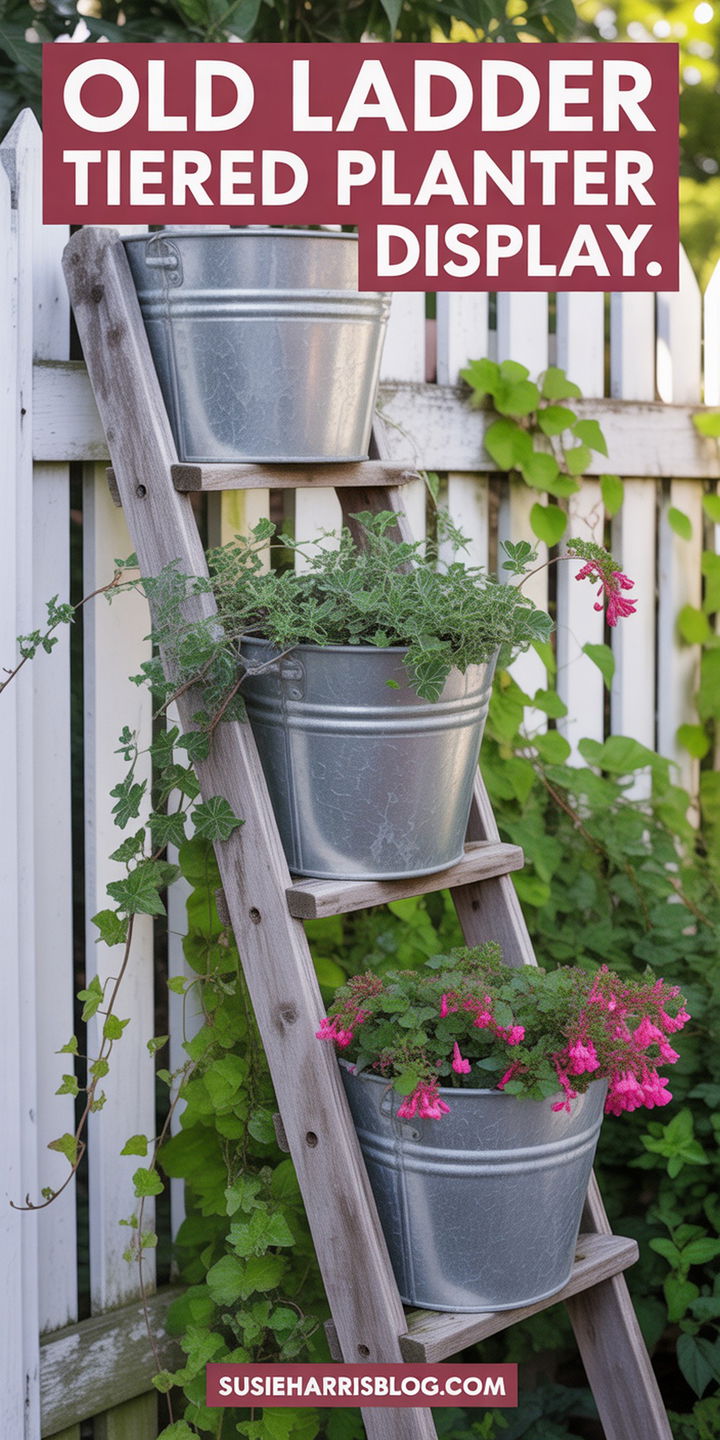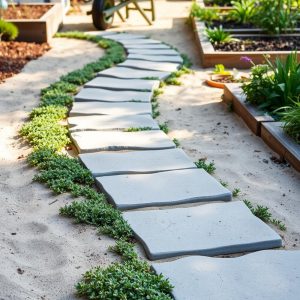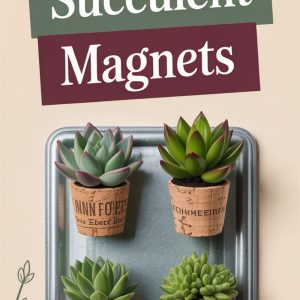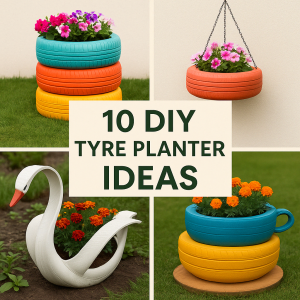Why Upcycled Container Gardens Are the Hottest DIY Trend
Upcycled container gardens blend creativity, sustainability, and style into every home and outdoor space. By repurposing everyday objects—vintage teacups, denim pockets, wine barrels, and even broken chairs—you can craft unique planters that showcase personality while reducing waste. These container gardens cater to beginners and seasoned gardeners alike, offering low‑cost, low‑maintenance solutions for growing herbs, succulents, and flowering plants. Whether you live in a compact urban apartment or have a sprawling backyard, these inventive planters make efficient use of vertical and horizontal spaces. The tactile appeal of weathered wood, rusted metal, and faded fabric also introduces textural contrast, transforming any corner into a botanical focal point. Plus, custom themes—fairy oases in old suitcases or industrial herb racks made from steel pipes—encourage experimentation and conversation, making gardening an engaging, hands‑on hobby for adults and kids.
Tips for Successful and Stylish Upcycled Plant Displays
To ensure your upcycled container garden thrives, start by choosing objects with adequate depth and the ability to drain excess water. Drill or poke drainage holes where necessary, and always line unconventional planters with gravel or landscape fabric to prevent root rot. Select soil mixes tailored to plant type—cactus mix for succulents, rich loam for annuals, and well‑draining blends for herbs. Position your creations where they receive optimal sunlight: south‑facing windows for indoor herb racks, shaded patios for fern‑filled coconut shells, and full‑sun decks for colorful blooms in wine barrels. Don’t forget routine care: mist moisture‑loving ferns, deadhead spent flowers, and rotate planters to promote even growth. Finally, rotate seasonal plants and swap accessories like fairy lights or mosaic tiles to keep your display fresh. With these strategies, your upcycled container gardens will not only look stunning but also flourish year‑round.
1. Rustic Teacup Succulent Garden
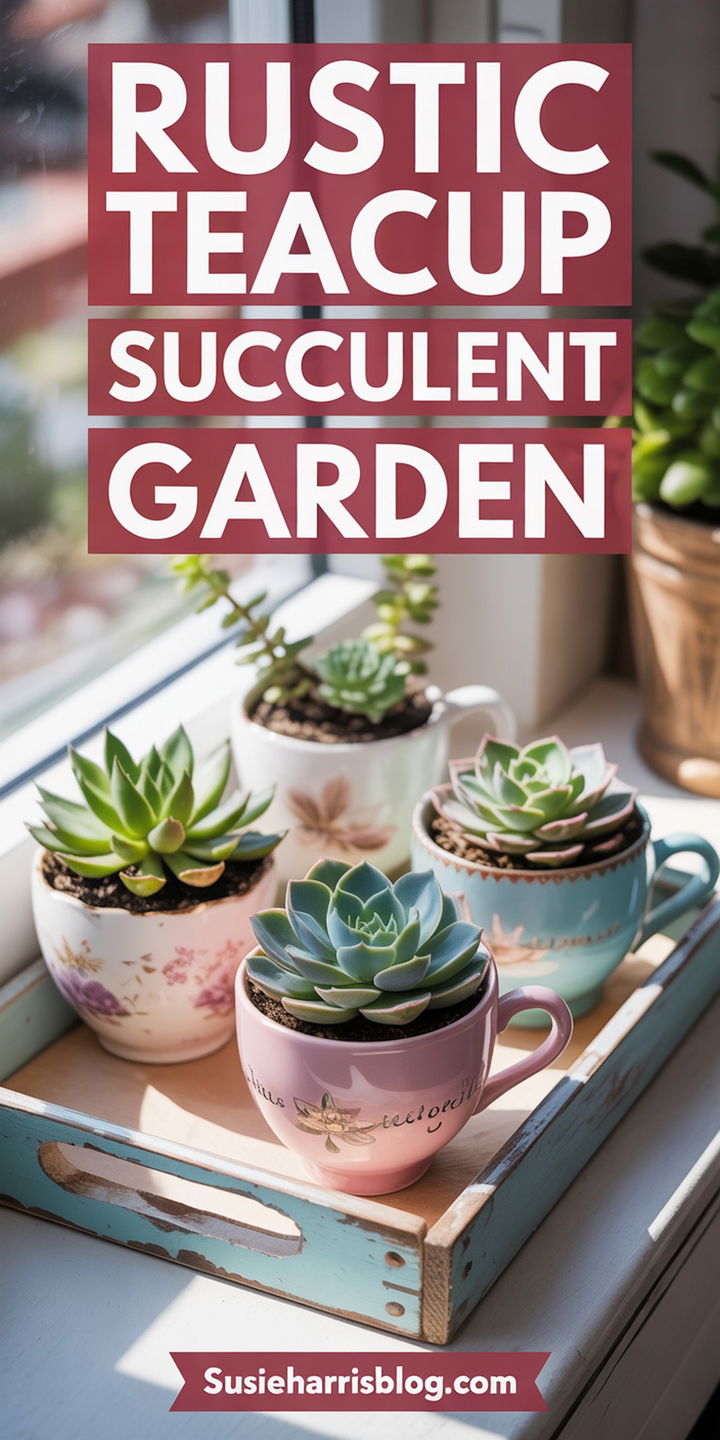
Transform chipped teacups into charming miniature landscapes by planting low‑maintenance succulents in each cup. Arrange them on a reclaimed wood tray or windowsill for a delightful rustic vignette that brightens any room. To enhance drainage, place a small layer of gravel at the bottom before adding cactus mix soil. Pair pastel china patterns with contrasting green hues of echeveria and haworthia for eye‑catching appeal. Perfect for apartment dwellers or as thoughtful handmade gifts, these dainty gardens require minimal watering and add a whimsical, cozy touch to kitchen nooks, bedside tables, or office desks.
Supplies
- Chipped or vintage teacups
- Small gravel or pebbles
- Cactus‑mix potting soil
- Assorted small succulents (echeveria, haworthia, etc.)
- Reclaimed wood tray or saucer
2. Industrial Pipe Herb Planters

Create an urban‑chic statement by assembling galvanized steel pipes into staggered tiers for fresh kitchen herbs. Secure horizontal runs of pipe to a sturdy plywood board, drill drainage holes, and fill with potting soil. Plant your favorite herbs—basil, rosemary, thyme—so they cascade or stand tall in perfect rows. Mount the finished display above the countertop to maximize space and ensure easy access while cooking. The raw metal finish pairs beautifully with reclaimed brick walls or white subway tile, adding functional flair to modern lofts, cafés, or outdoor patios. With proper sunlight and weekly watering, your industrial herb garden will thrive and impress guests.
Supplies
- Galvanized steel pipes (various lengths and diameters)
- Plywood or reclaimed wood backboard
- Pipe flanges and mounting screws
- Drill with metal‑drill bits
- Potting soil
- Herb seedlings (basil, rosemary, thyme)
- Gravel for drainage
3. Vintage Suitcase Fairy Oasis
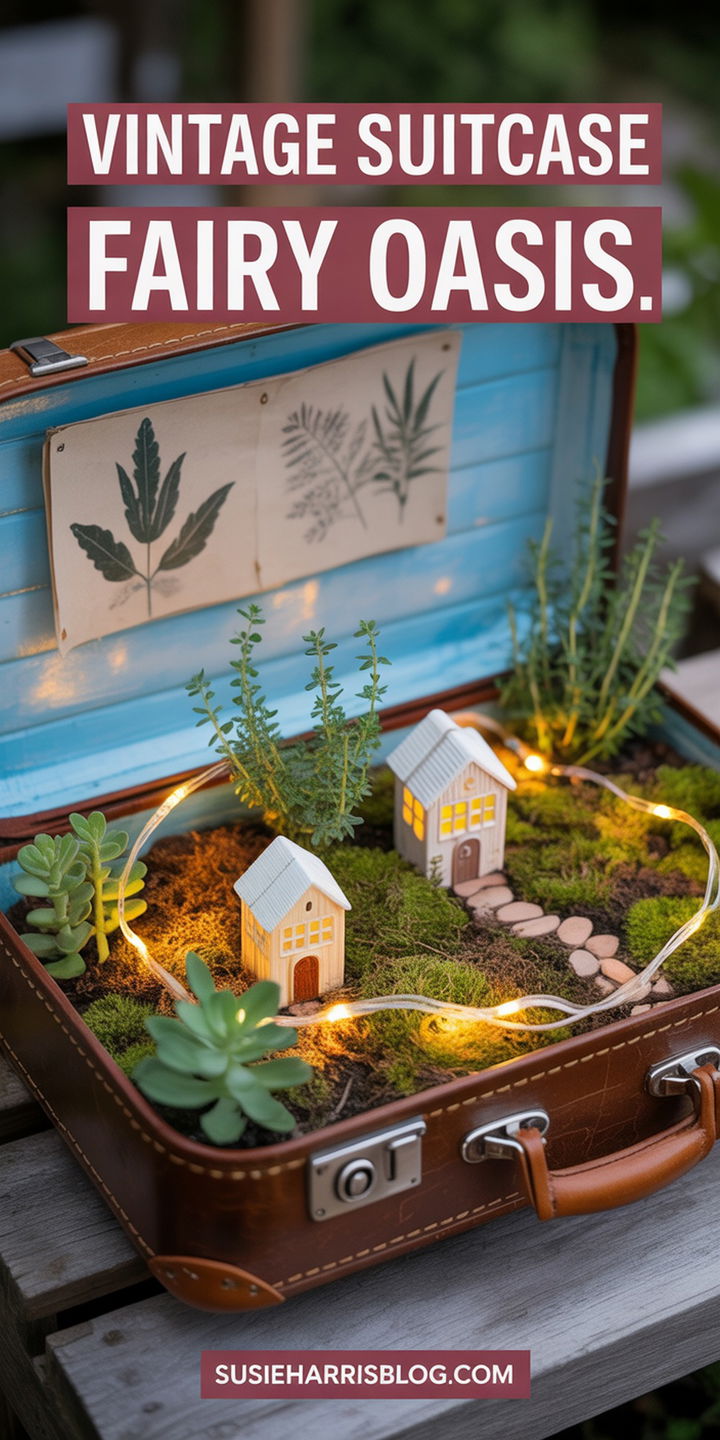
Repurpose a weathered vintage suitcase into a miniature fairy garden by layering moss, pebbles, and soil inside. Add tiny resin houses, miniature benches, and LED fairy lights tucked among small ferns and creeping thyme. The hinged lid creates an enchanting backdrop—paint its interior sky blue or line it with botanical‑print fabric for extra charm. Display on a console table, bookshelf, or porch ledge to spark conversation and whimsy. Perfect for birthday parties, garden-themed weddings, or as unique home décor, this portable oasis invites you to let your imagination roam. Simply mist weekly and swap out seasonal accents for year‑round magic.
Supplies
- Weathered vintage suitcase
- Sheet moss
- Small pebbles or gravel
- Potting soil
- Miniature fairy garden accessories (houses, benches, LED lights)
- Botanical‑print fabric or paint (optional for lid interior)
- Small ferns and creeping thyme
4. Worn Leather Boot Flower Display
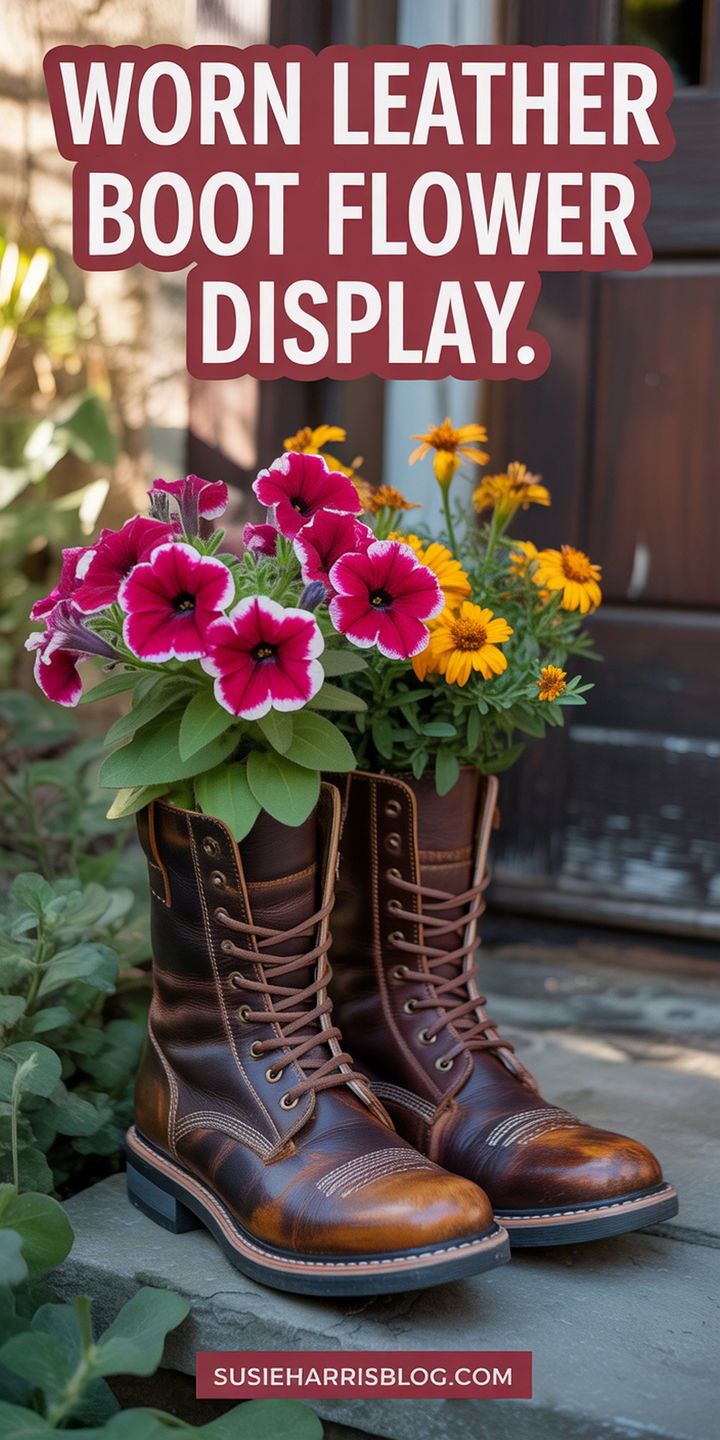
Give an old pair of leather boots new life by filling them with hearty annuals like marigolds, petunias, or pansies. Start by lining the interior with landscape fabric, then add gravel for drainage and quality potting mix. The boots’ natural patina and rich tones contrast beautifully with vibrant blossoms, creating a quirky focal point on patios, entryways, or garden paths. For extra stability, secure boots in a shallow tray or nestle among stones. This upcycled planter requires regular watering—check soil moisture twice weekly—and benefits from deadheading spent blooms. It’s a conversation starter that celebrates creativity and sustainability in outdoor décor.
Supplies
- Old leather boots
- Landscape fabric
- Gravel or small stones
- Quality potting mix
- Annual flower seedlings (marigolds, petunias, pansies)
- Shallow tray or stones for stability
5. Mason Jar Windowsill Herb Rack
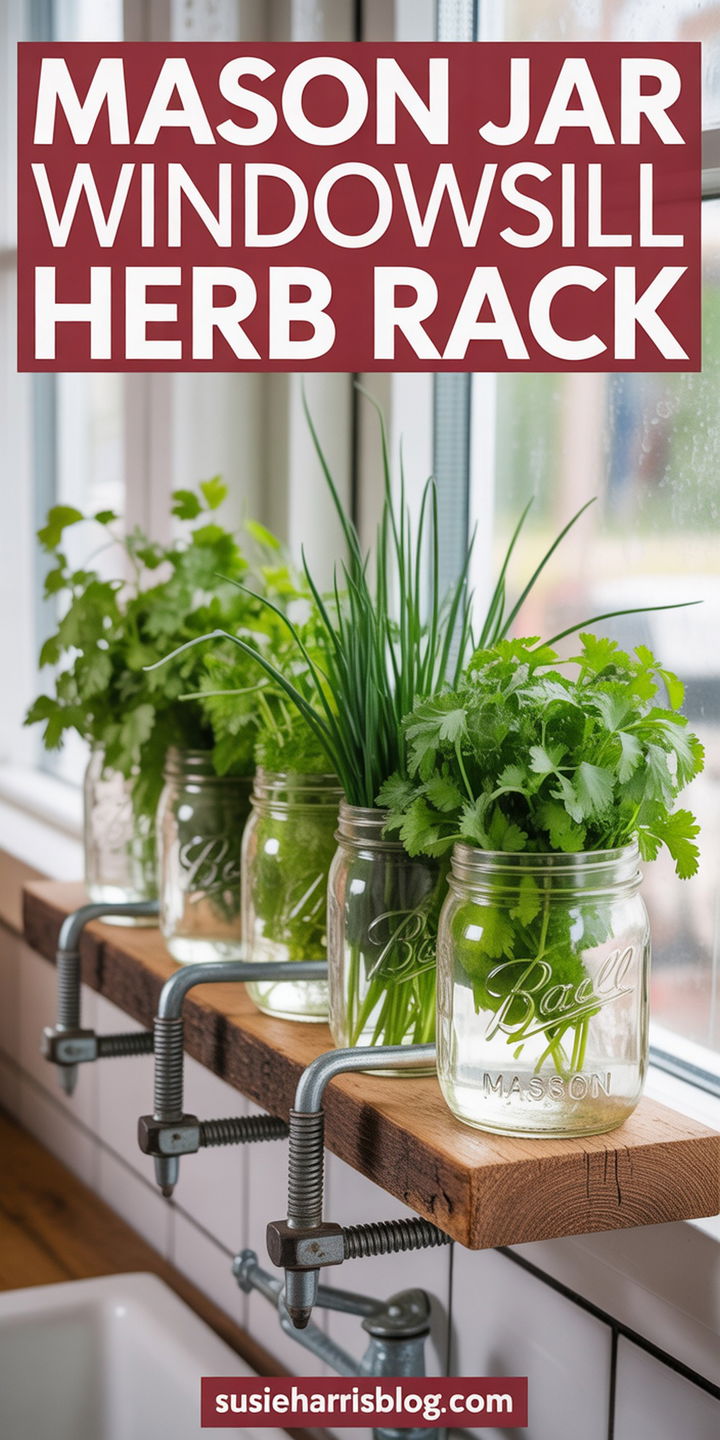
Assemble an easy DIY herb station by attaching rustic wood planks to the wall above your kitchen sink. Fasten metal hose clamps or jar holders to the plank, then slide in glass Mason jars filled with potting soil and your choice of culinary herbs—cilantro, chives, parsley. The clear glass allows you to monitor moisture levels while the plank can be stained or painted to match your décor. This compact design maximizes sunlight exposure and keeps fresh herbs at arm’s reach. Ideal for small kitchens or renters, the rack offers year‑round greenery and culinary convenience without sacrificing countertop space.
Supplies
- Wood plank (stained or painted)
- Metal hose clamps or jar holders
- Screws and wall anchors
- Mason jars
- Potting soil
- Herb seedlings (cilantro, chives, parsley)
6. Old Ladder Tiered Planter Display
Transform an old wooden ladder into a charming multi‑level plant display by leaning it against a wall or fence. Place galvanized buckets, terracotta pots, or reclaimed wooden boxes on each rung, filling them with trailing ivy, fuchsia, or kalanchoe. The varying heights create depth and dimension, perfect for displaying a mix of foliage and flowering plants. Seal the ladder with weather‑resistant varnish to ensure longevity outdoors. This versatile design works on balconies, in garden corners, or even indoors near bright windows. Water from the top down to let overflow gently irrigate lower levels—an effortless way to keep all plants hydrated and thriving.
Supplies
- Wooden ladder (old or reclaimed)
- Galvanized buckets, terracotta pots, or wooden boxes
- Weather‑resistant varnish or sealant
- Potting soil
- Assorted trailing and upright plants (ivy, fuchsia, kalanchoe)
7. Repurposed Wine Barrel Patio Oasis
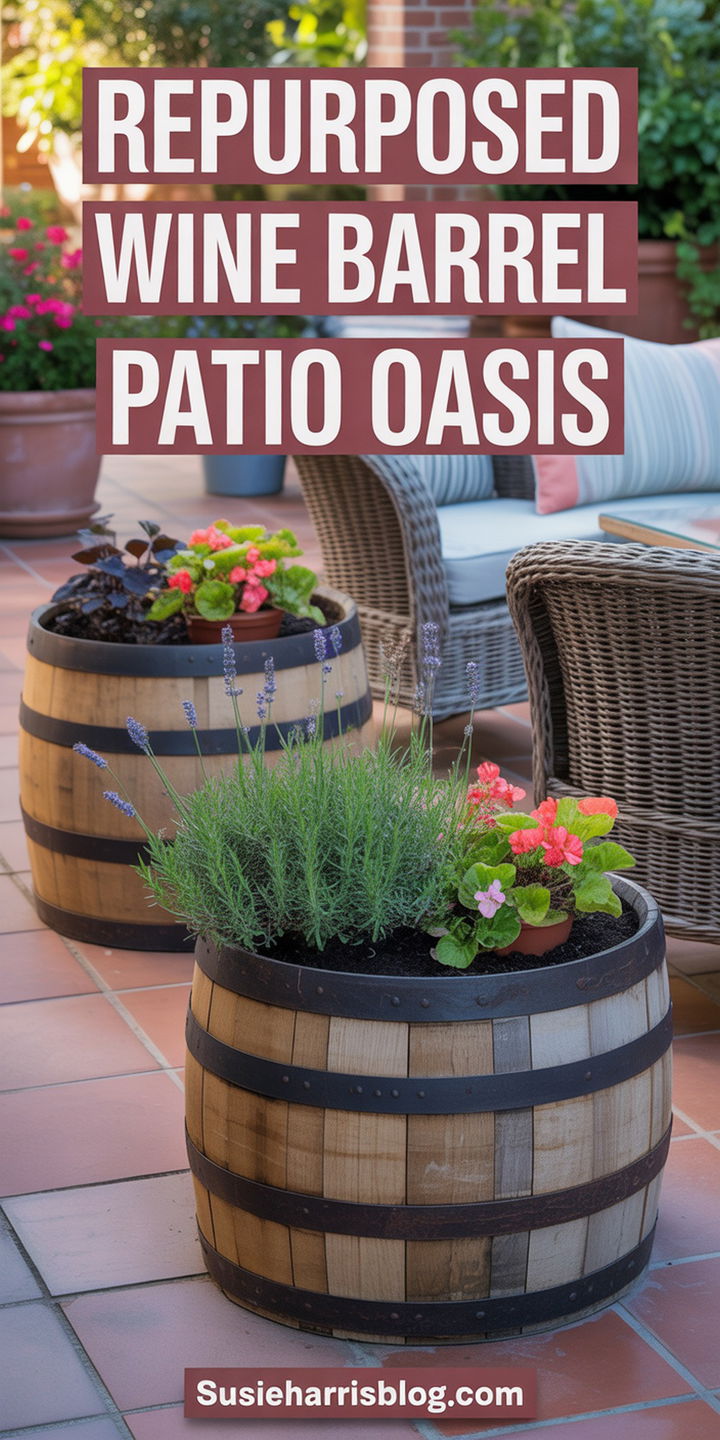
Slice an old oak wine barrel in half, seal the cut edges, and fill each curved half with rich soil to create rustic patio planters. Plant aromatic lavender, rosemary, and sage for a Mediterranean vibe, or mix colorful begonias and calibrachoa for a burst of summer blooms. The weathered wood imparts natural warmth, while the barrel’s rounded shape softens hardscape lines. Position the barrels on either side of a seating area or entryway for symmetry. Regular watering and occasional fertilizing will keep your patio oasis lush, and the barrels’ sturdy construction withstands seasons of sun and rain with minimal upkeep.
Supplies
- Oak wine barrel halves
- Wood sealant for cut edges
- Potting soil
- Mediterranean herbs (lavender, rosemary, sage) or flowering annuals (begonias, calibrachoa)
- Fertilizer
8. Denim Pocket Succulent Wall
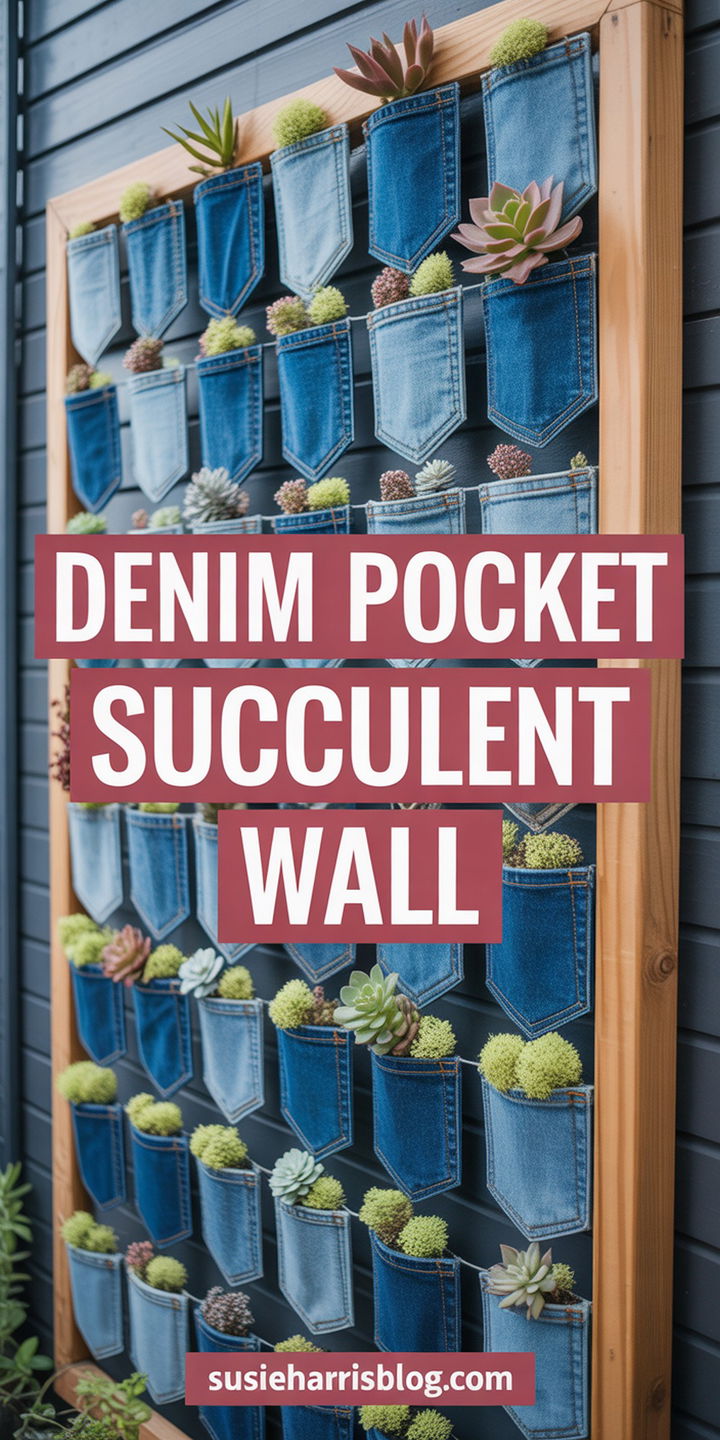
Collect mismatched denim jeans, then cut out the back pockets along with a strip of surrounding fabric. Secure these pocket patches onto a wooden frame or canvas using upholstery tacks, creating a grid of mini planters. Insert small succulents—sedum, crassula, or sempervivum—into each pocket, ensuring soil retention with a bit of sphagnum moss. Hang the finished piece on an outdoor fence, balcony railing, or bright indoor wall for a chic upcycled display. The blue denim tones complement green succulents beautifully, and the texture adds depth. Water sparingly—only when the moss feels dry—to prevent overwatering.
Supplies
- Old denim jeans
- Scissors
- Upholstery tacks or heavy‑duty glue
- Wooden frame or canvas
- Sphagnum moss
- Succulents (sedum, crassula, sempervivum)
9. Tin Can Pendant Succulent Lights
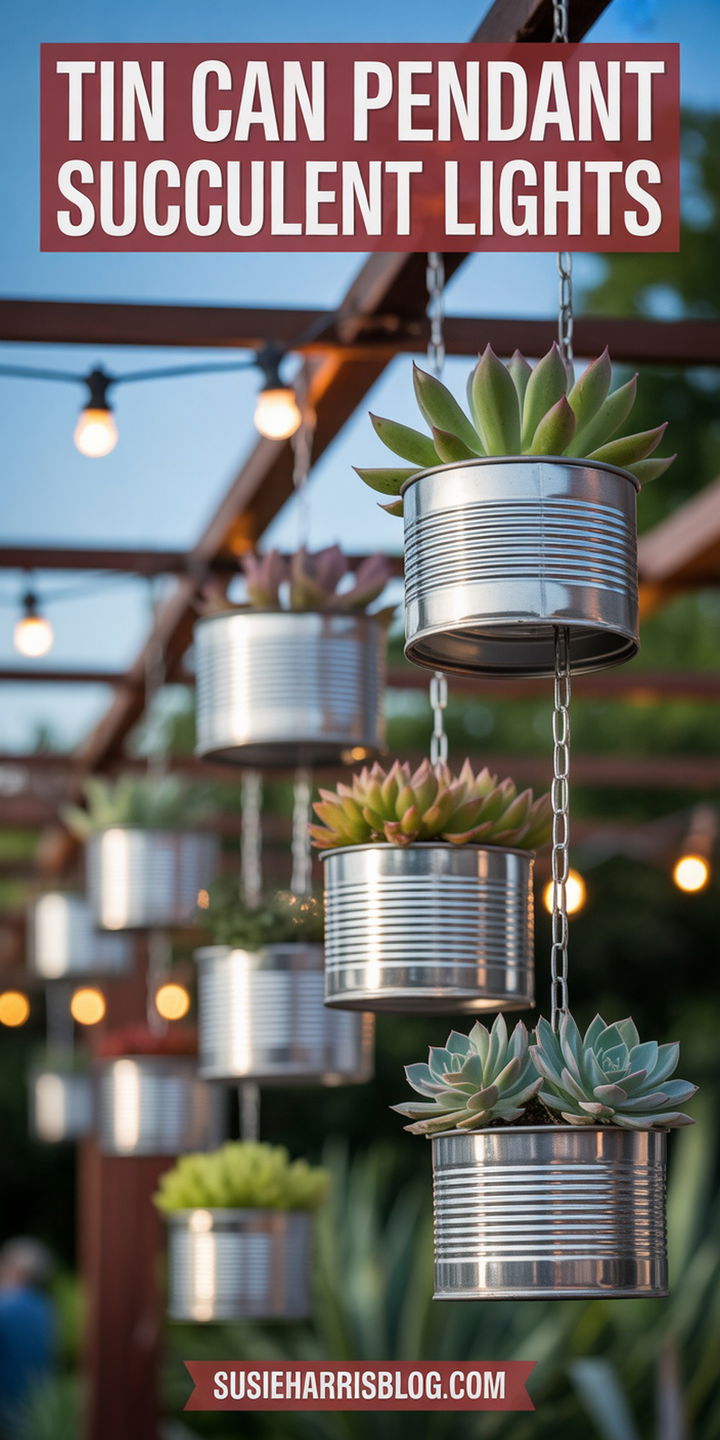
Upcycle cleaned tin cans into hanging pendant planters by punching drainage holes in the bottom and drilling two small holes for hanging wire near the rim. Thread sturdy twine or metal chain through the holes, knot securely, and fill each can with a mix of succulent-friendly soil and gravel. Plant colorful succulents like echeveria, sedum, or aeonium so they peek over the edge. Hang a cluster at varying heights under a porch roof, pergola, or even indoors near a sunny window. The metallic finish catches light during the day, while the trailing succulents soften urban spaces, blending industrial with botanical charm.
Supplies
- Cleaned tin cans
- Drill and small metal‑drill bit
- Twine or metal chain
- Gravel or pebbles
- Succulent‑friendly soil mix
- Colorful succulents (echeveria, sedum, aeonium)
10. Broken Chair Vertical Flower Garden
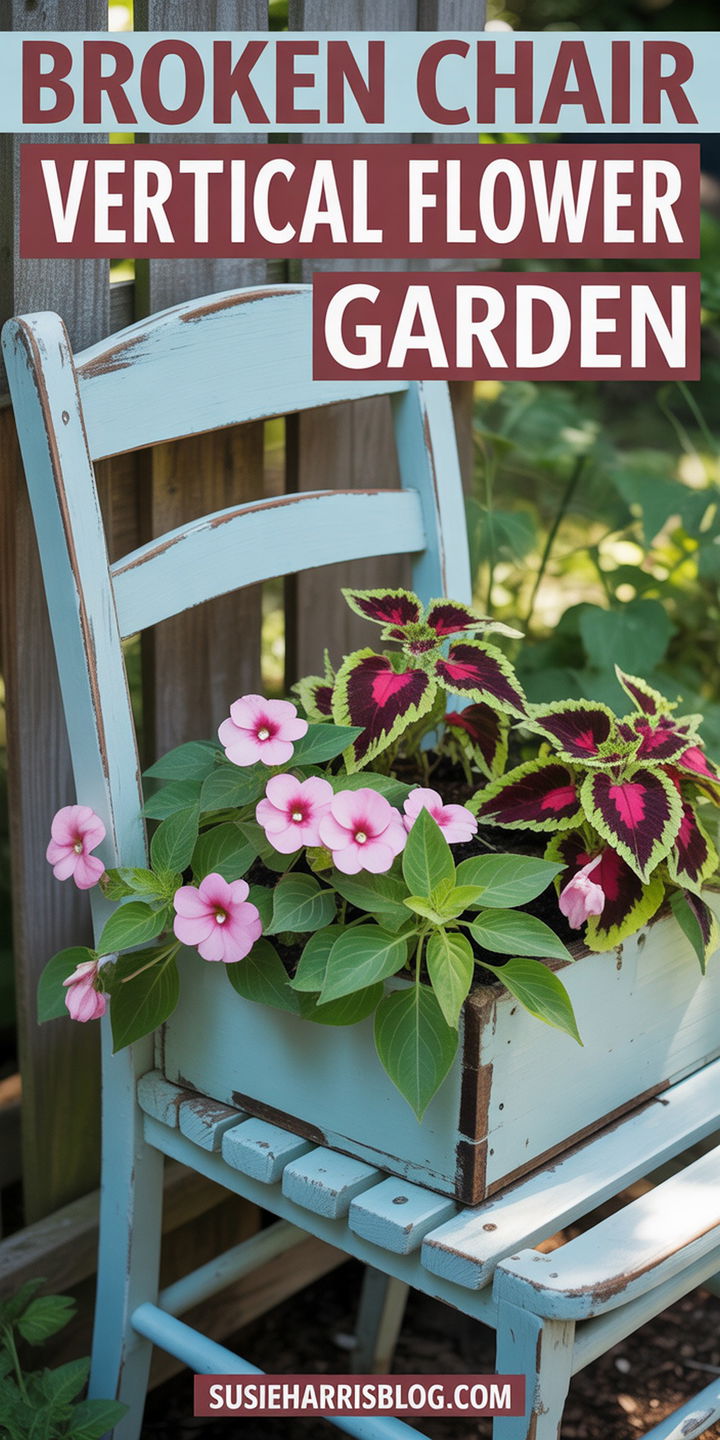
Give a broken wooden chair new purpose by removing one front leg and tilting it against a wall or fence. Replace the seat with a sturdy planter box or attach galvanized tubs across the rungs of the backrest. Plant a mix of colorful annuals and perennials—impatiens, coleus, or fuchsias—for cascading foliage. Paint the chair in bright hues or distress it for shabby‑chic appeal. This vertical installation conserves ground space and creates a focal point in small gardens or tiny patios. Water by misting from top to bottom, letting excess trickle down. It’s an eco‑friendly statement piece that celebrates creativity and resourcefulness.
Supplies
- Broken wooden chair
- Planter box or galvanized tubs
- Screws or zip ties
- Paint (optional)
- Potting soil
- Annuals and perennials (impatiens, coleus, fuchsias)
11. Discarded Bicycle Basket Blooms
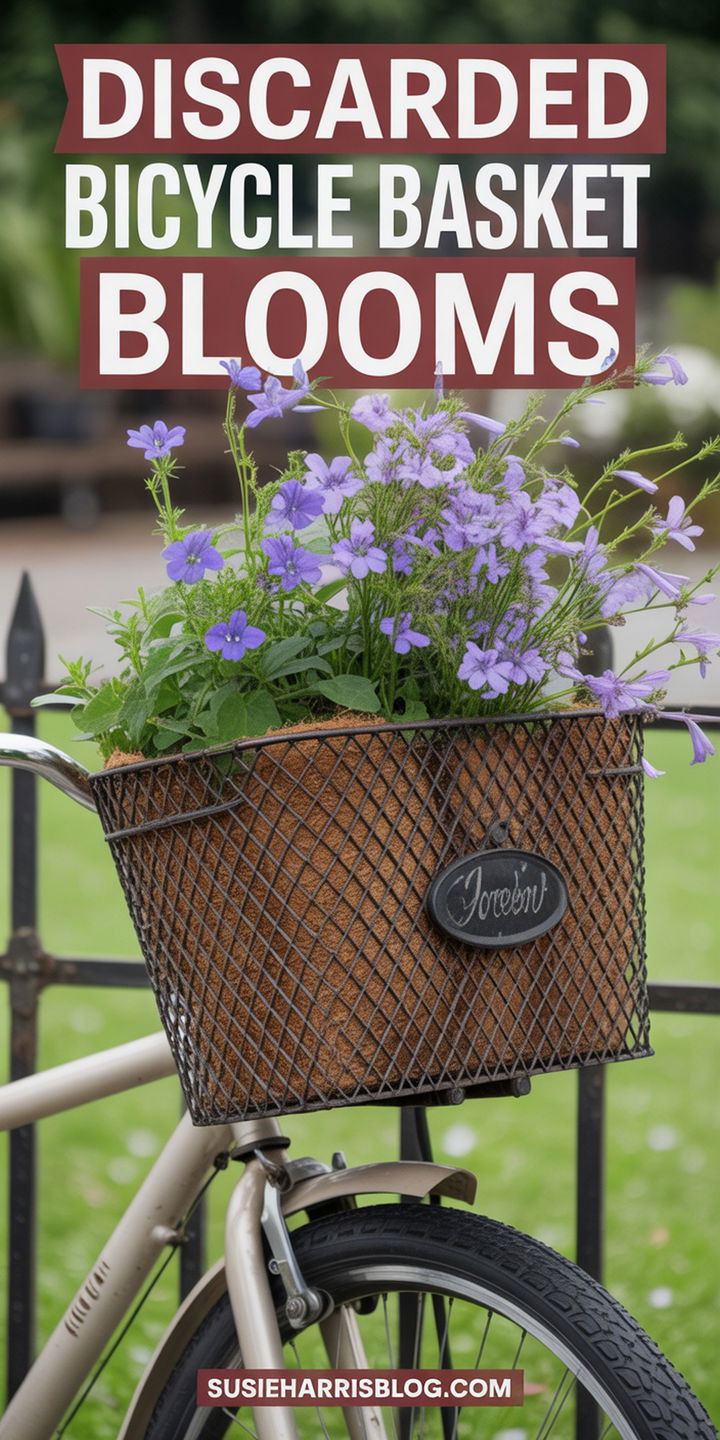
Mount an old bicycle frame or just its front basket to a garden wall or fence, then line the basket with coconut coir or moss. Fill with potting soil and plant trailing calibrachoa, lobelia, and fuchsia for a whimsical, tumbling effect. The vintage bike frame adds nostalgia, while the vibrant blooms spill elegantly over the basket’s edge. Hang near your porch or garden entrance to greet guests with cheerful color. Water lightly every few days, ensuring excess drains freely. This bicycle basket planter combines movement and stillness in a single display—perfect for lovers of upcycling and story‑rich décor.
Supplies
- Old bicycle frame or front basket
- Coconut coir liner or moss
- Potting soil
- Trailing flowers (calibrachoa, lobelia, fuchsia)
12. Tea Kettle Miniature Herb Sanctuary
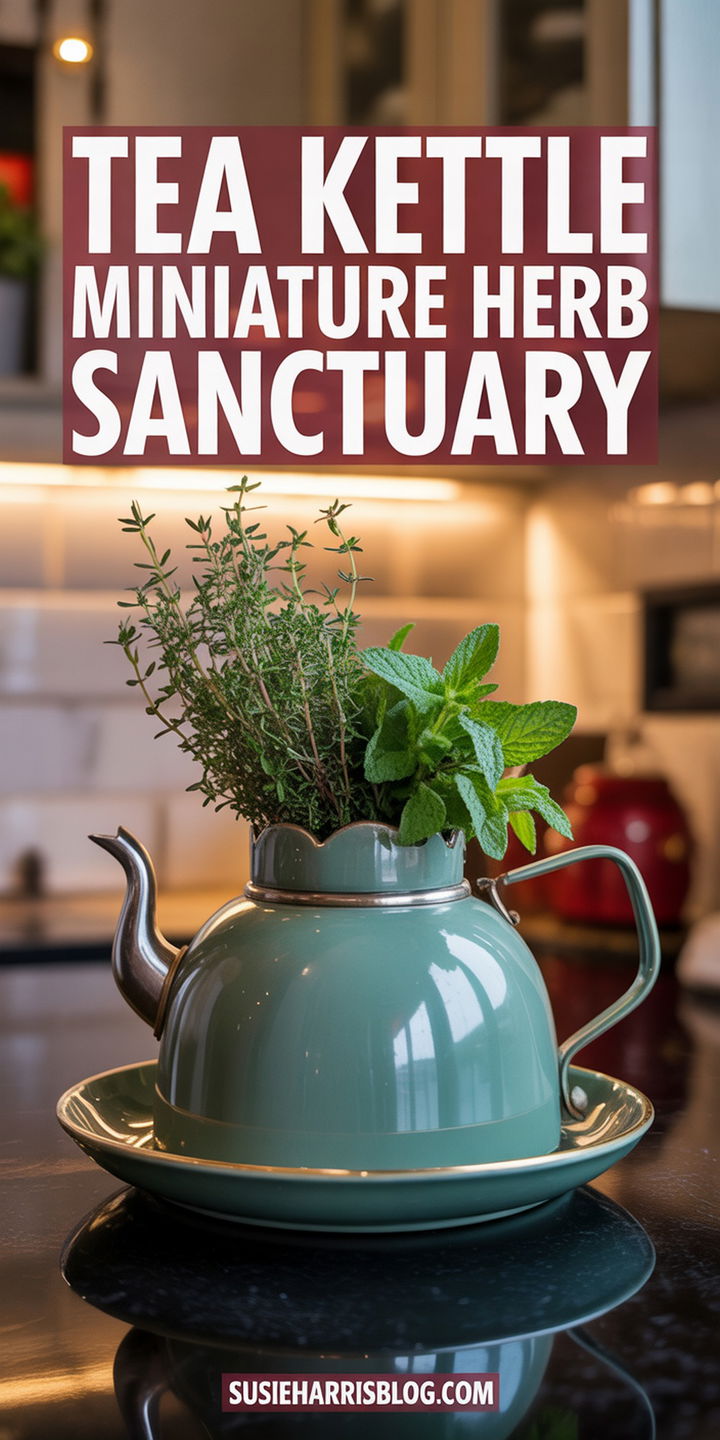
Transform a vintage tea kettle into a charming countertop herb planter by drilling small drainage holes in the base. Fill halfway with pebbles for drainage, then top with organic potting mix and tiny herbs like thyme, oregano, or mint. Place on a saucer to catch any overflow and display next to your stove or windowsill for quick access while cooking. The kettle’s nostalgic form and glossy finish contrast beautifully with lush green herbs, adding both function and flair. Water sparingly to avoid rust, and enjoy a unique kitchen accent that brings fresh flavor and personality to your home.
Supplies
- Vintage tea kettle
- Drill with small‑bit for drainage holes
- Small pebbles
- Organic potting mix
- Mini herb seedlings (thyme, oregano, mint)
- Saucer
13. Coconut Shell Hanging Fern Fest
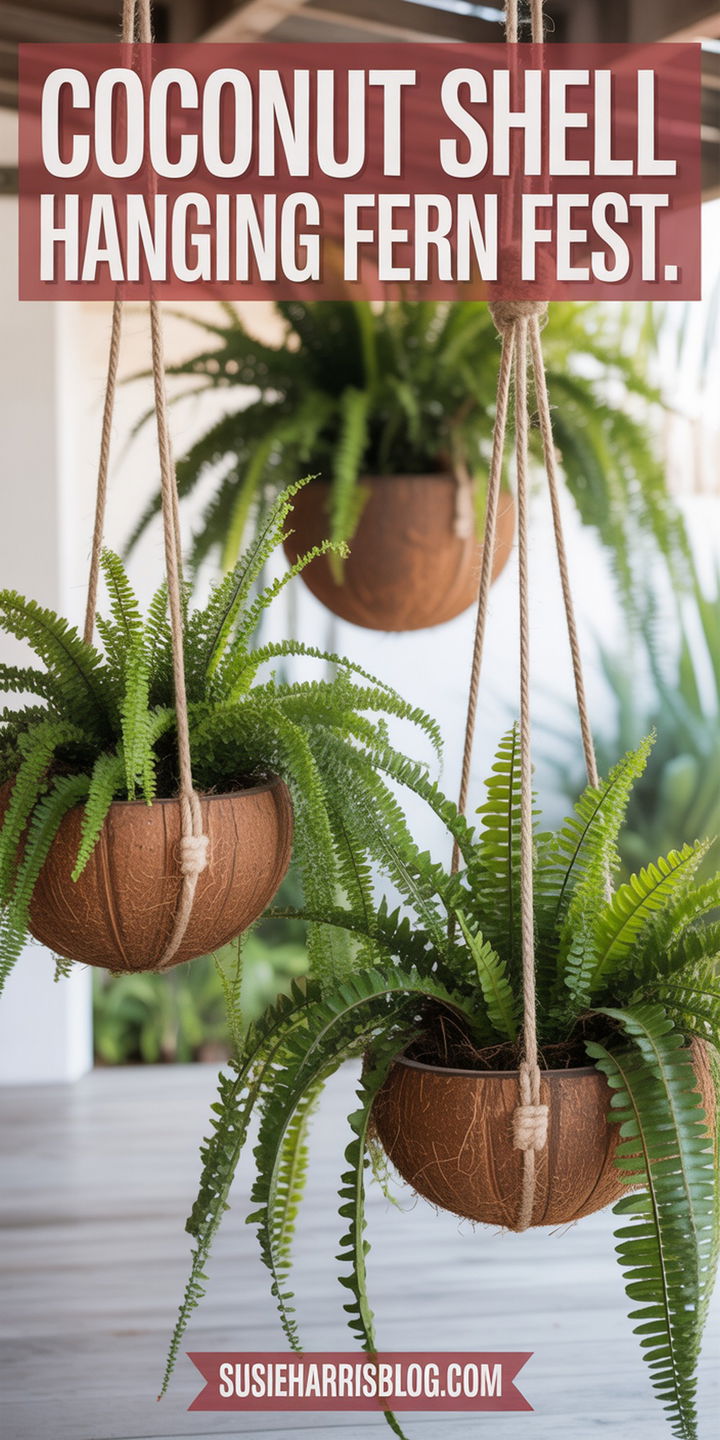
After enjoying a coconut, clean and dry the halved shell, then line it with a layer of mesh to hold soil. Attach three or four lengths of jute rope around the shell’s rim, knotting at the top to form a hanger. Plant lush Boston ferns, maidenhair ferns, or staghorn fern pups inside, letting fronds cascade naturally. Hang these tropical beauties in shaded patios, porches, or bright bathrooms for a humid‑loving environment. The organic coconut texture complements verdant foliage, creating a boho‑chic vibe. Mist weekly and water when the top inch of soil feels dry to maintain healthy, vibrant ferns.
Supplies
- Halved coconut shells
- Mesh or landscape fabric
- Jute rope
- Boston, maidenhair, or staghorn fern pups
- Potting soil
14. Wooden Pallet Climbing Vine Frame
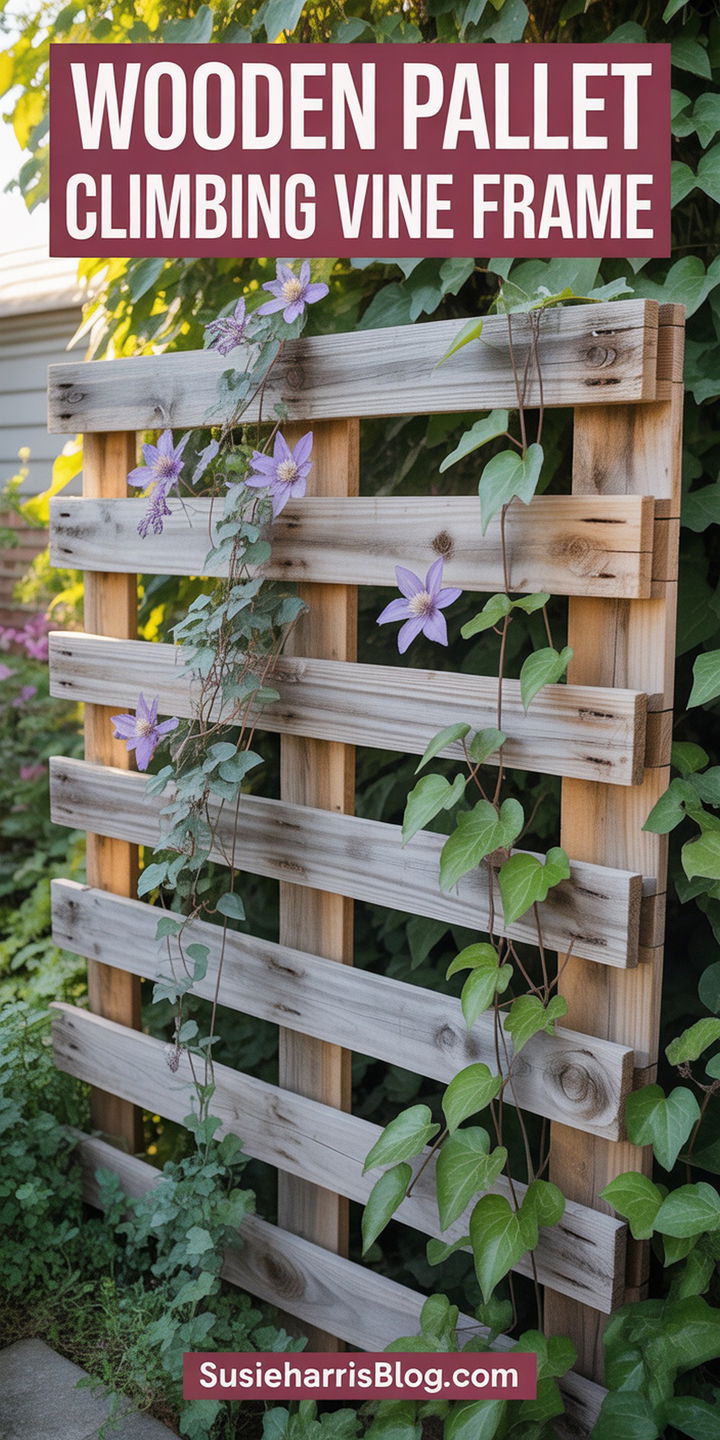
Lean or mount a reclaimed wooden pallet against an outdoor wall or fence, then weave climbing vines—English ivy, sweet pea, or clematis—through its slats. At the base, secure small pots or plant directly into raised beds adjacent to pallet legs. As vines grow, they’ll climb the frame, creating a living green wall with vertical interest. Seal the wood to protect against rot, and space vines evenly for full coverage. This cost‑effective design turns any bland barrier into a verdant focal point while maximizing vertical space. Water at the base to encourage deep root growth and train vines as they ascend.
Supplies
- Reclaimed wooden pallet
- Wood sealant
- Climbing vine seedlings (English ivy, sweet pea, clematis)
- Small pots or raised bed soil at base
15. Ceramic Tile Mosaic Trough Planter
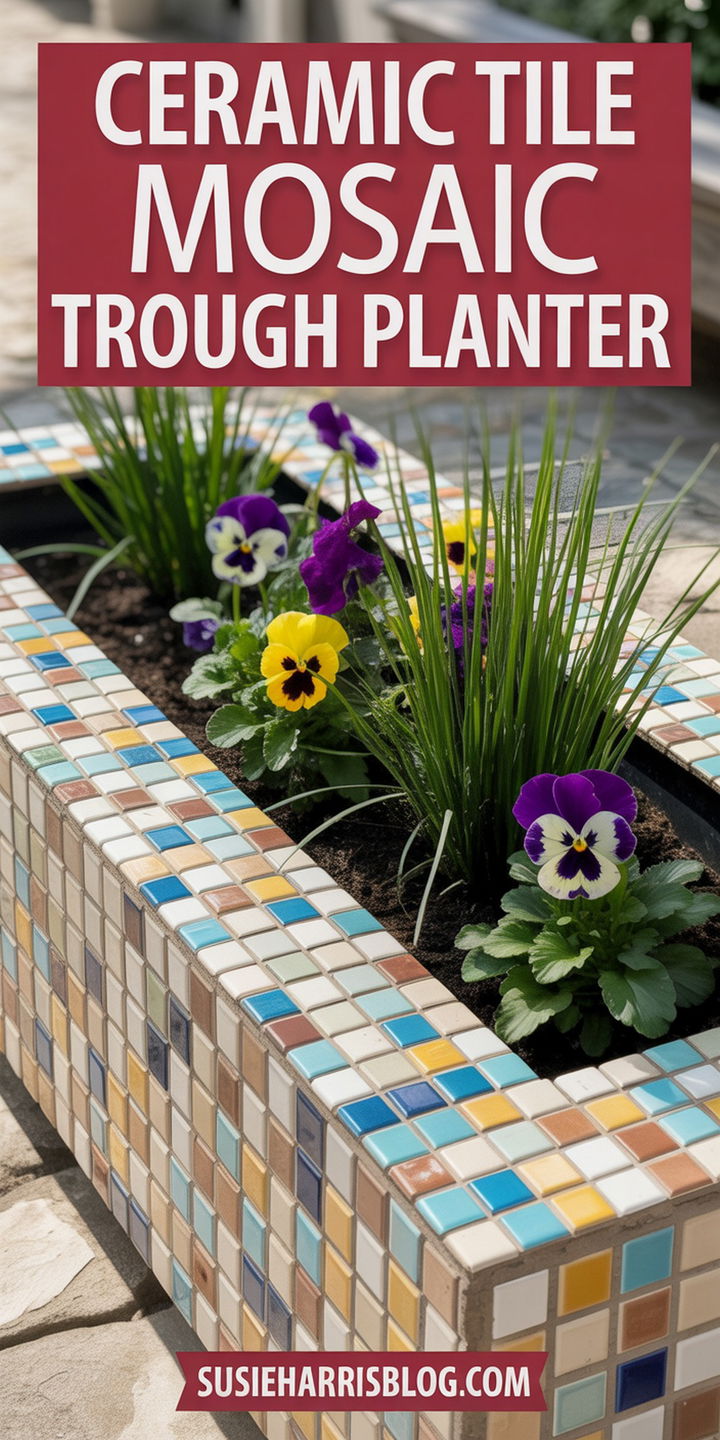
Give an old trough or rectangular planter a fresh face by adhering broken ceramic tiles in assorted colors to its outer surface using weatherproof adhesive. Grout the gaps for a seamless mosaic finish, then fill with soil and plant a mix of ornamental grasses, dwarf shrubs, or seasonal blooms like pansies and violas. The intricate tile pattern adds Mediterranean flair, while the trough’s generous depth accommodates diverse root structures. Place on patios, balconies, or along garden borders to introduce a burst of color and texture. Clean mosaic surfaces with a gentle brush and water to maintain shine and longevity.
Supplies
- Old trough or rectangular planter
- Broken ceramic tiles or tile chips
- Weatherproof adhesive and grout
- Grout float and sponge
- Potting soil
- Ornamental grasses, dwarf shrubs, or seasonal blooms (pansies, violas)

